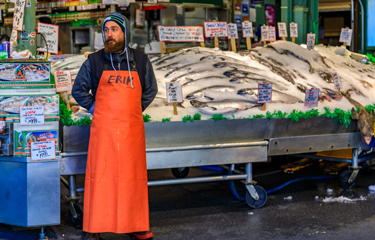A recently published study has called into question a cornerstone policy argument for segments of the American seafood industry.
For years, government officials, aquaculture proponents, industry experts, and even environmentalists have consistently cited that 90 percent of the seafood consumed in the U.S. comes from foreign markets. However, three researchers say that oft-repeated statistic is misleading, and that the actual figure is closer to 65 percent.
The issue Jessica Gephart, Halley Froehlich and Trevor Branch have with the 90 percent figure is that it creates an assumption all imports contain only foreign caught fish.
“Although this may seem logical, it is not always the case; large quantities of seafood landed in the United States are exported for processing and shipped back into the United States,” they wrote in an opinion piece for the Proceedings of the National Academy of Sciences of the United States of America.
They also note that the United Nations Food and Agriculture Organization’s calculations estimate imported products only account for 70 percent of U.S.-consumed seafood.
According to the researchers, China takes in 31.3 percent of all American seafood exports. Of that, about 57 percent comes back after processing to the U.S. By factoring in that return, plus accounting for unreported catches at about eight percent – based on the most recent statistics available – that would bump down NOAA’s 90 percent figure to about 65 percent.
John Ewald, NOAA Fisheries director of public affairs, did not dispute the study’s findings. However, he said that Gephart, Froehlich, and Branch calculated the percentage of foreign-origin fish in the products we consume.
“This is different than total seafood imports, which includes processed products made in foreign countries from U.S.-origin fish,” Ewald told SeafoodSource in a statement.
With that understanding, if Alaskan companies were able to process more of their own catch, or find cost-effective processors elsewhere in the U.S., that would put a significant dent into the 90 percent figure.
While this may seem like a debate about semantics, and while both sides still show the country facing a seafood trade deficit, it can impact U.S. policy.
Under the Trump administration, government officials have touted the 90 percent figure as the main reason for exploring ways to increase domestic catch and production.
“Aquaculture and U.S. wild-capture fisheries are both critical components of our Blue Economy, and we are committed to spurring innovation and expanding opportunities throughout the seafood supply chain for our fishermen, fish farmers, fishing communities, and seafood consumers,” Ewald said.
Obviously, more domestic production would lead to more jobs in the U.S., not just within the seafood industry but elsewhere when factoring in the secondary effects the new jobs would create.
However, the researchers note that expanding wild fisheries will not likely put a dent into the reliance on imports.
“(T)he opportunities to expand catch volume, including opening the marine monuments that only ever produced a tiny fraction of total production, are dwarfed by our current imports,” they note. “Furthermore, the targeted wild species are generally not substitutes for less expensive, farmed imports.”
As a result, they claim U.S. fisheries would be better served by policies that expand their access to foreign markets. That brings into question the country’s aggressive trade policies, especially against China and the European Union.
Since the world’s two largest economies have become embattled in a trade war by ratcheting tariffs on each other’s goods, the seafood industry has been severely impacted. And it’s not only affecting Alaskan products, which get hit twice – once by China and once by the U.S. on return.
Maine lawmakers have been pushing for relief for its lobstermen, which have a USD 1.5 billion (EUR 1.3 billion) economic impact on the state’s economy.
Last month, U.S. Sen. Susan Collins wrote to NOAA Fisheries senior advisor for seafood strategy asking him to help. In late April, Michael Rubino was named to the newly created position to lead the agency’s efforts on such issues as aquaculture and market access.
In the letter, Collins noted that Maine enjoyed a 169 percent increase in lobster sales to China for the first six months of 2018. But once China levied a 25 percent tariff on U.S. lobsters last June, those sales have dropped precipitously as Chinese businesses are forging deals with Canadian dealers.
“I am eager to work with you to develop new and expand existing markets for lobster and other American seafood to help replace those lost in both China and the E.U.,” she wrote.







